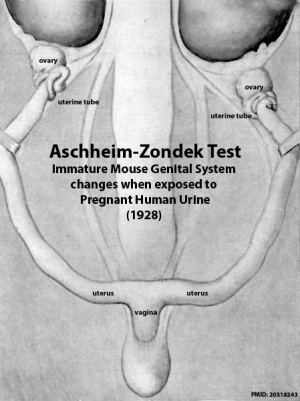 | ||
Rabbit test 1978
The rabbit test, or "Friedman test", was an early pregnancy test developed in 1931 by Maurice Harold Friedman and Maxwell Edward Lapham at the University of Pennsylvania as an improvement on the 1927 test developed by Bernhard Zondek and Selmar Aschheim. The original test actually used mice, and was based upon the observation that when urine from a woman in the early months of pregnancy is injected into immature female mice, the ovaries of the mice enlarge and show follicular maturation. The test was considered reliable, with an error rate of less than 2%. The rabbit test consisted of injecting the tested woman's urine into a female rabbit, then examining the rabbit's ovaries a few days later, which would change in response to a hormone secreted only by pregnant women. The hormone, human chorionic gonadotropin (hCG), is produced during pregnancy and indicates the presence of a fertilized egg; it can be found in a pregnant woman's urine and blood. The rabbit test became a widely used bioassay (animal-based test) to test for pregnancy. The term "rabbit test" was first recorded in 1949 and became a common phrase in the English language.
Contents
Modern pregnancy tests still operate on the basis of testing for the presence of the hormone hCG. Due to medical advances, use of a live animal is no longer required.
It is a common misconception that the injected rabbit would die only if the woman was pregnant. This led to the phrase "the rabbit died" being used as a euphemism for a positive pregnancy test. In fact, all rabbits used for the test died, because they had to be surgically opened in order to examine the ovaries. While it was possible to do this without killing the rabbit, it was generally deemed not worth the trouble and expense.
A replacement for the rabbit test involved using frogs, specifically the African clawed frog, which like all frogs lays eggs instead of getting pregnant, and therefore can yield a positive result on the test without the need to be cut open in order to prove it.
